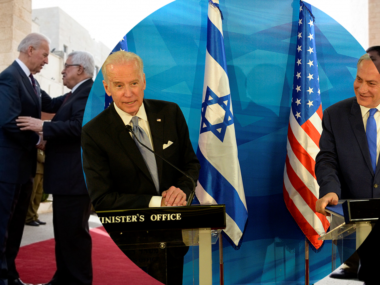By Andrew Kydd
As the negotiations over the Iranian nuclear program grind to a halt, we are likely to see the topic of an Israeli preventive strike on Iran return to the prominence it enjoyed this spring. Back then analysts speculated that it was only a matter of time before the Israelis attacked, and that the Obama Administration would find it politically impossible, in an election year, to prevent them from doing so or to punish them after the fact. Sanctions and negotiations were billed as the last chance to prevent war, a chance appears to be slipping away. It is therefore not too soon to rejoin this debate, for perhaps the last and decisive time.
One historical analogy that is constantly raised in this context is the Holocaust. The Nazi genocide against the Jews, killing six million, led to the founding of Israel and indelibly colored Jewish views of the world. The lesson Israelis have drawn from it, and rightly so, is that you must be strong in a world of people who hate you, weakness invites disaster. The analogy has been invoked to justify a preventive attack on Iran. Anti-semitism and holocaust denial is rife in Iranian leadership circles. They seek nuclear weapons with which they could kill millions of Jews. Therefore they must be stopped from developing them. This syllogism seems very convincing to potential targets of Iranian nuclear armed missiles, understandably.
The Israelis of today, however, are not the European Jews of 1939. For one thing, they have a state with the most powerful conventional armed forces in the region. For another, Israel possesses around 200 nuclear weapons. This means that the holocaust analogy runs into certain difficulties. At the Wannsee conference of January 1942 the top Nazi officials formalized their plans for the final solution. Can we imagine the same decisions being made if the Jews of 1942 possessed a state with 200 nuclear weapons? In that case, opting for genocide would mean accepting the loss of Berlin, Hamburg, Munich, and 197 other German cities, on the day of the initial assault. It is difficult to imagine that these officials would have made such a decision, or been allowed to.
What this suggests is that the correct type of historical analogy is not to the holocaust or to mass murder in general, but to full scale military assaults on formidable adversaries. These decisions are where the risks are all or nothing and the costs can run into the tens of millions of casualties. This is the province of the study of war and deterrence. The key events to look to for analogies then become the German decision for war in 1914, and again in 1939, 1940 and 1941, and US-Soviet relations during the Cold War. What does this history have to tell us? As these dates suggest, states have been willing to undergo the risks and costs of initiating total war against strong adversaries. In 1914 Germany attacked, fearing that it was growing weaker in comparison to Russia and would eventually be unable to deter it. In 1939, 1940 and 1941, Hitler attacked Poland, France, Britain, and the Soviet Union, convinced that blitzkrieg tactics would produce quick victories, and was correct twice. However, since the invention of nuclear weapons no great power has ever launched a full scale assault against another great power. Indeed no state has ever launched a full scale assault against a clearly nuclear armed state. The one borderline case is the 1973 joint Egyptian-Syrian attack on Israel, which some believed possessed nuclear armaments. However, Israel had not tested nuclear weapons, openly deployed them, or made any deterrent threats, so its nuclear deterrent could hardly be weaker. In addition to the Yom Kippur War, China and Russia skirmished over some small islands in the 1960s and India and Pakistan fought the very limited Kargil war in 1999 after their nuclear tests. However, since the advent of nuclear weapons we have seen no all out assaults reminiscent of Operation Barbarossa or the Six Day War on a nuclear-armed state. Raw historical analogy would therefore suggest that nuclear weapons have a perfect track record at deterring full scale attacks.
A final analogy to consider is the US-Soviet Cold War, a protracted struggle between nuclear armed adversaries during which nuclear war appeared to be a potential outcome of at least three crises: Berlin, Cuba and Able Archer. Deterrence optimists point out the obvious macro historical fact — none of these crises led to war. Pessimists argue the details and point to the real risks that arose. This is a reasonable, indeed vital, debate to have and where analysis should focus in assessing the risks of letting Iran go nuclear.







3 comments